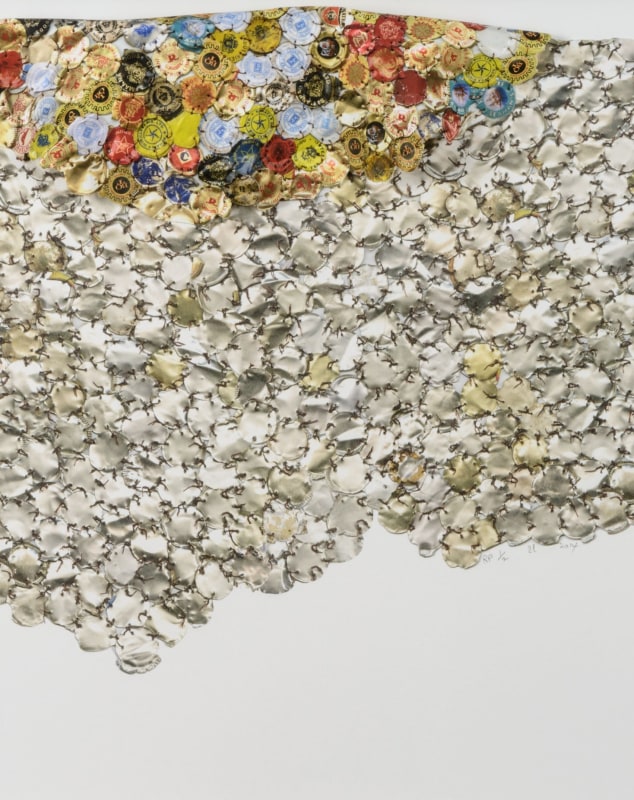
El Anatsui (b. 1944)
El Anatsui was born in Ghana in 1944. He now lives and works in Ghana and Nigeria where he continues to create wholly inventive artworks that are both powerful and sublime. Anatsui received his BA from the Collage of Art, University of Science and Technology, Kumasi, Ghana in 1969 and has been teaching at the University of Nigeria, Nsukka since 1975.
El Anatsui’s works are immediately recognizable. He transforms appropriated objects into site-specific sculptures, changing their forms each time they are installed. Using bottle caps, copper wire, metal plates, steel, tin and fabric, these works morph into colossal tapestries of mesmerizing works of art. The communal process aspect of his artwork sets him apart from many of his contemporaries. He works with curators, installers and his team to mold and warp the monumental sculptures into new renditions noting that he doesn’t “want to be a dictator. [He] wants to be somebody who suggests things.” These complex assemblages defy easy categorization and transcend limitations of space as they are mutable and ever changing each time they are displayed.
Massive in scale, these works are both luminous and weighty. Famous for his use of detritus, Anatsui is interested in the conversation that his pieces bring up as he merges personal, local and global concerns as well as issues of colonialism, globalism, waste and consumerism. All of these themes and concerns are evidenced as discarded bottle caps and other materials sourced from Ghana and Nigeria. Not only do the liquor bottle caps that he’s most famous for represent themes of waste, consumerism and globalism, they also point to the early slave trade between Africa, Europe and The United States, where bottle caps acted as a sort of bartering tool.
Anatsui’s works are stunningly beautiful and deep with metaphorical and poetic meaning. At once exquisite and gem-like, these works can also be seen as industrialized and weighty. The nonrepresentational nature of his work references the history of abstraction in Africa and Europe and the United States. It has been noted that Anatasui’s works are in fact a wholly new African medium. The New York Time’s Roberta Smith wrote “…the works evoke lace but also chain mail; quilts but also animal hides; garments but also mosaic, not to mention the rich ceremonial cloths of numerous cultures. Their drapes and folds have a voluptuous sculptural presence, but also an undeniably glamorous bravado.”
Anatsui is included in numerous private and public collections including the Metropolitan Museum of Art, New York, the Museum of Modern Art, New York, the Brooklyn Museum, New York, the Des Moines Art Center, Iowa, the Centre Pompidou, Paris, the Los Angeles County Museum of Art, California, the Bill and Melinda Gates Foundation, Washington, the Akron Art Museum, Ohio, the St. Louis Art Museum, Missouri, the Museum Kunstpalast, Dusseldorf, the Setagaya Museum, Tokyo, and the British Museum, London. Solo shows of El Anatsui’s work have been exhibited at the Brooklyn Museum, New York and the Des Moines Art Center in Iowa, and currently on view at the Museum of Contemporary Art, San Diego. Anatsui has been featured in many international exhibitions, including the Venice Biennale in both (1990) and (2007) and the Paris Triennial in (2012). Large scale public installations, including Broken Bridge II, commissioned by High Line Art and presented by Friends of the High Line, was on view on a wall next to the High Line from (2012-2013), and Tsiatsia – Searching for Connection, which was installed on the façade of the Royal Academy of Arts in London in summer (2013).
